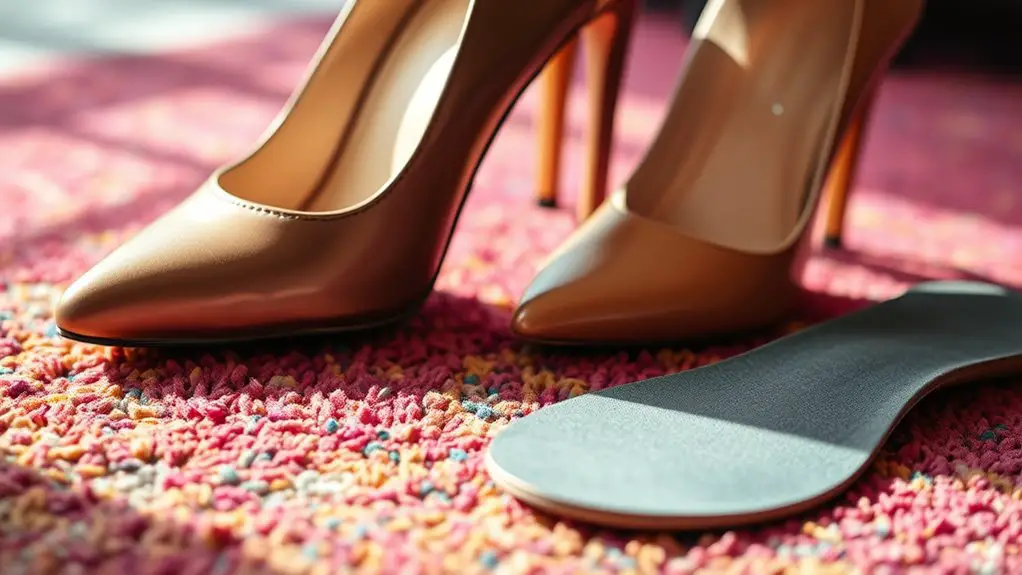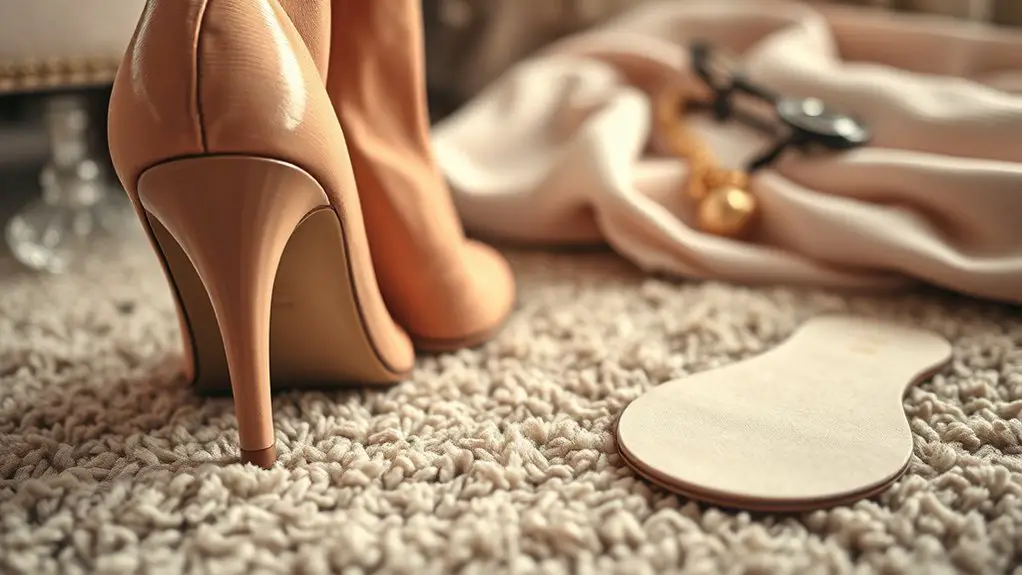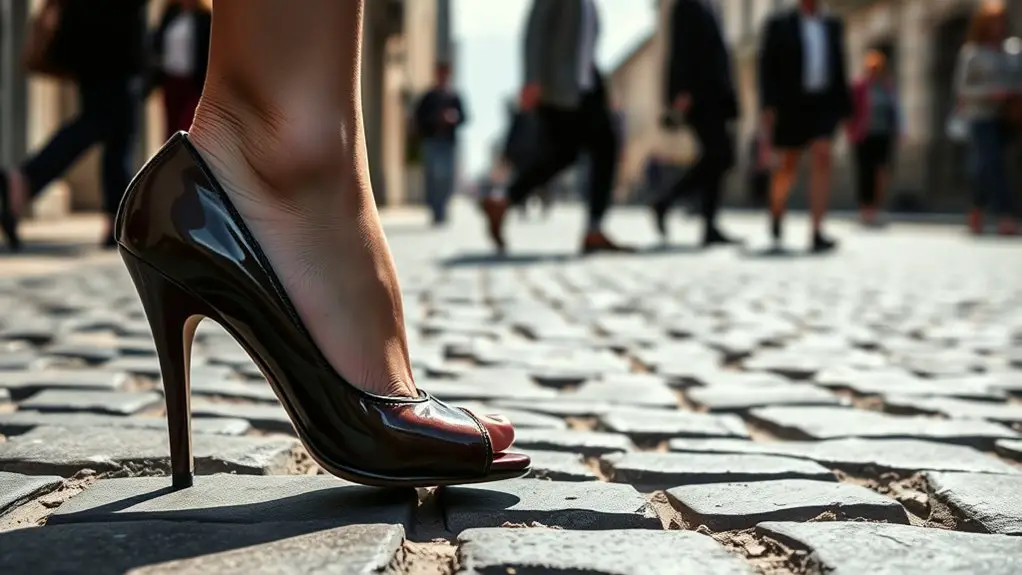If your heels feel unstable, it could be due to muscle weakness, improper alignment, or ill-fitting shoes. Previous injuries might lead to scar tissue affecting your heel’s function. Proper shoe fit is essential; a snug heel reduces the risk of slipping. Additionally, adequate arch support can improve stability and comfort. To enhance your heel security, focus on choosing well-designed shoes and consider orthotic inserts. There’s more to discover about optimizing your heel comfort and stability.
Common Causes of Unstable Heels

When you experience unstable heels, it often stems from several common causes. The heel anatomy plays a vital role in your overall stability. Weakness in muscles surrounding the heel, such as the calf and intrinsic foot muscles, can lead to instability. Additionally, improper alignment and biomechanics during movement can exacerbate the issue. If you’ve had previous injuries, scar tissue may affect your heel’s functionality, making balance difficult.
Balance training is fundamental to improving heel stability. Engaging in exercises that target strength and proprioception can enhance your muscle coordination and support your heel. Incorporating activities like single-leg stands or balance boards can help correct imbalances. Moreover, evaluating your footwear to guarantee it doesn’t hinder your heel’s support can be beneficial. Understanding these common causes is the first step toward achieving stable heels and improving your overall mobility.
Importance of Proper Fit
Proper fit in footwear is essential for maintaining heel stability and overall foot health. Ill-fitting shoes can lead to instability, discomfort, and even injury. When selecting shoes, it’s vital to pay attention to heel measurements, as they greatly affect how securely your foot rests in the shoe. Many people underestimate size variations across different brands, which can contribute to improper fit. You might wear one size in one brand and a different size in another, so always try on shoes before purchasing. A proper fit should allow for a snug heel without slipping, ensuring your foot stays properly aligned during movement. Additionally, consider the width—narrow or wide options can make a significant difference in comfort and stability. By prioritizing the importance of proper fit, you can greatly reduce the risk of unstable heels and promote better foot health.
The Role of Arch Support

Although many people overlook it, adequate arch support is essential for maintaining heel stability and preventing discomfort. The human foot comprises different arch types—high, neutral, and flat—which influence foot mechanics during movement. When your arches lack proper support, the alignment of your feet can be compromised, leading to instability in your heels.
Inadequate arch support can cause excessive pronation or supination, which affects how forces are distributed throughout your foot. This misalignment may result in pain not just in your heels but also in your knees, hips, and lower back.
To enhance heel stability, consider using orthotic inserts tailored to your specific arch type. These inserts provide the necessary support, helping to optimize foot mechanics and reduce discomfort. By addressing arch support, you’ll not only improve your heel stability but also promote overall foot health and functionality.
Shoe Design and Stability
While many may underestimate the impact of shoe design on heel stability, the right footwear is essential for preventing instability and discomfort. Proper heel construction plays a vital role in ensuring your heels feel secure. Shoes with a well-designed heel counter provide necessary support, reducing the risk of rolling or slipping.
Additionally, the choice of outsole materials greatly affects traction and stability. Rubber outsoles, for instance, offer superior grip compared to harder materials, minimizing the chance of losing footing. Shoes with a wide base can also enhance balance, as they distribute weight more evenly.
When selecting footwear, consider both the heel construction and the quality of the outsole materials. Prioritizing stability-oriented designs will not only improve your overall comfort but also protect you from potential injuries associated with unstable heels. Investing in the right shoes is a proactive step towards better foot health.
Tips for Enhancing Heel Comfort and Security

To enhance heel comfort and security, it’s vital to focus on fitting and support. Start by ensuring your shoes fit properly; they shouldn’t be too tight or loose. Look for models that offer adequate heel cushioning, which absorbs shock and reduces pressure on your feet. Additionally, consider insoles designed specifically for heel support, as these can provide extra stability.
Traction improvements are also important. Shoes with rubber soles or specialized tread patterns can prevent slipping, giving you greater confidence in your movements. When selecting footwear, prioritize designs that incorporate both cushioning and stability features, such as arch support and a snug heel counter.
Lastly, remember to regularly assess your shoes for wear and tear. Replacing worn-out footwear can greatly enhance your heel comfort and security. By following these tips, you’ll create a more supportive environment for your feet, reducing instability and discomfort.
Frequently Asked Questions
Can Unstable Heels Lead to Long-Term Foot Problems?
Unstable heels can indeed lead to long-term foot problems. When your heel pain disrupts proper foot alignment, it may result in chronic issues like plantar fasciitis or misalignment, affecting overall mobility and comfort over time.
Are There Specific Exercises to Strengthen My Heels?
Yes, incorporating heel exercises and balance training into your routine can greatly strengthen your heels. Focus on calf raises, toe stands, and single-leg balances to enhance stability and support overall foot health.
How Often Should I Replace My Shoes for Stability?
You should replace your shoes every 300 to 500 miles, as shoe lifespan varies. Look for stability indicators like worn-out treads or discomfort. Ignoring this can lead to instability and potential injuries over time.
What Materials Provide the Best Support for Unstable Heels?
For unstable heels, look for shoes with good arch support and cushioning materials like memory foam or gel. These features help absorb shock, enhance stability, and reduce discomfort, ensuring a more secure and comfortable walking experience.
Can Weight Gain Affect Heel Stability?
Yes, weight gain can affect heel stability. It alters weight distribution and body posture, leading to additional pressure on your heels. This imbalance can increase the risk of instability and discomfort while standing or walking.



